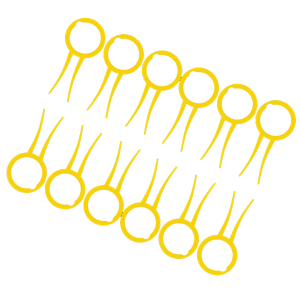Liposomal
Encapsulation
Technology
Are supplements a waste of money?
There’s certainly no point in taking a supplement if your body simply degrades and excretes the contents before the nutrients have a chance to do any good.
That is a waste of money.
If you are taking supplements, you are taking them for a reason. You are either looking to address a specific health concern or you want to optimise your overall health and well-being.
How easily a nutrient can be absorbed by the body and the mechanism of entry is the driving force behind the innovation of liposomal encapsulation and lipolife.
What is a liposome?

The phospholipid
[ fos-foh-lip-id ]
Phospholipids are the building blocks of human cells and also lipolife liposomes. Phospholipids are amphipathic (a compound containing both polar (water-soluble) and nonpolar (not water-soluble) portions in its structure) and are characterised by having a lipophilic tail and hydrophilic head.
The phospholipid bilayer
Phospholipids in your cell membrane are arranged in two layers, called a phospholipid bilayer. This same bilayer forms a liposome.


The liposome
[ li-poh-sowm ]
The name liposome is derived from two Greek words: ‘Lipos’ meaning fat and ‘Soma’ meaning body.
A lipolife liposome is formed from a phospholipid bilayer through the introduction of water and energy.
Nutrients are encapsulated inside the lipolife liposome bubble. The liposome can carry either fat-soluble nutrients such as Vitamin D3 or water-soluble nutrients like Vitamin B12.
Liposomal encapsulation technology encapsulates bioactive compounds to enhance bioavailability. As they are able to carry both fat and water-soluble payloads, liposomes are ideal for nutrient bioavailability.
Bioavailability is key for nutrients to reach their full potential and efficacy. In order to offer health benefits, vitamins and minerals must reach the target tissue.
Why
Liposomal Encapsulation?
Digestion. The digestive process starts in the mouth.
Your saliva contains special enzymes such as amylase, lysozyme and lingual lipase which, as you chew, help to begin breaking down starch and fats in the food. Once swallowed, food travels down the oesophagus and enters your stomach, a bath of more enzymes and acid. Stomach acid, also known as hydrochloric acid, needs to be strong enough to continue the digestive process and dissolve food into a pulp for onward journey into the small intestine and absorption through the intestinal lining.
As well as its role in digestion, your stomach acid also acts as the first line of defence against pathogens and microbes that could make you sick. The pH of stomach acid is 1 or 2, only slightly higher than battery acid which is capable of dissolving steel.
Your stomach lining is comprised of a protective mucus consisting of, amongst other materials, phospholipids. The same phospholipids that build our cell membranes and lipolife liposomes.

Let Phoebe Liebling give you the lowdown on liposomes in 60 seconds.

Regular Supplements
The moment you take a regular vitamin pill, the digestion process begins. Your powerful digestive system breaks down and dissolves a large amount of the supplement contents through digestion, metabolism and excretion.
This entire process slows and reduces the nutrients’ bioavailability. Sometimes as little as 10% – 20% of the nutrient reaches systemic circulation.
That’s an expensive visit to the toilet.
LIPOSOMAL DELIVERY
How does a liposome help nutrient absorption?
Oral liposomes, like food particles, travel down the intestinal tract through the stomach and into the small intestine.
The wonder of liposomes is they can be absorbed into circulation from the gastrointestinal tract at any point during their journey.
What makes liposomes extra special is that they can deliver their contents directly into the cells of the body, largely protecting the contents from digestion or oxidation before the final delivery and crucially, without the consumption of mitochondrial energy.
This results in more effective nutrient delivery which means less wastage for both your body and your bank balance.
How is a liposome absorbed?
ENDOCYTOSIS
The cell engulfs the liposome forming a membrane-bounded vesicle called an endosome.
ADSORPTION
The liposome wall adheres to that of the cell and releases its payload into the cell.
FUSION
The melding of the liposome
membrane with the membrane of the
cell, carrying the contents of the liposome into the cell.
LIPID EXCHANGE
The contents of the liposome and cell exchange their lipid contents.

